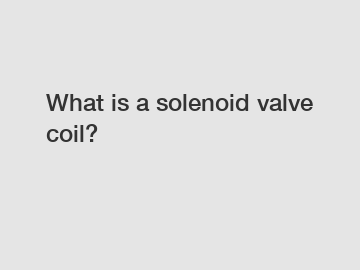Xingyu supply professional and honest service.
Solenoid valves are a vital part of various industries, providing precise control over fluid flow. These incredible devices rely on solenoid valve coils to exert their magnetic force, triggering efficient opening and closing actions. Today, we delve into the inner workings of solenoid valve coils, exploring their mechanisms, applications, and undeniable role in modern-day automation.
1. Understanding Solenoid Valve Coils:

A solenoid valve coil is an electromechanical component composed of tightly wound wire tightly packed around a core. Usually made of copper, the coil design enables it to generate a magnetic field upon the flow of electric current. This magnetic force is leveraged to actuate a valve plunger, controlling the flow or interruption of fluid in pipelines or machines.
2. Inner Workings and Mechanisms:
The solenoid valve coil plays a pivotal role in transforming electrical energy into mechanical action. When electric current passes through the coil, it creates a magnetic field based on the right-hand rule. The strength of this field depends on the current intensity and the number of turns in the coil. As a result, the magnetic force attracts or repels the ferromagnetic plunger, ultimately ensuring the valve's proper operation.
3. Applications across Industries:
Due to their versatility and precision, solenoid valves find applications in numerous industries and processes. Whether it’s fluid control in manufacturing lines, HVAC systems, irrigation, or medical equipment, solenoid valves equipped with coils offer reliable and efficient control. The automotive industry also greatly benefits from solenoid valve coils in fuel injection systems and transmission controls, enhancing performance and fuel efficiency.
4. Different Types of Solenoid Valve Coils:
Solenoid valve coils are available in various designs, each catering to specific applications. Here, we touch upon two primary types:
a) AC Solenoid Valve Coils: These coils are designed to operate with alternating current (AC) power sources. They offer considerable advantages, such as lower power consumption, quieter operation, and heat reduction. AC solenoid valve coils are commonly used in applications requiring continuous or long-duration operation.
b) DC Solenoid Valve Coils: Direct current (DC) solenoid valve coils are adept at providing quick and powerful responses to control signals. They are widely used in applications demanding frequent on-off cycles or high-speed responses, like pneumatic or hydraulic systems.
5. Factors Influencing Coil Selection:
Choosing the right solenoid valve coil involves considering specific factors to ensure optimal performance. Some crucial considerations include voltage compatibility, power consumption, duty cycle, operating temperature, and the environment in which the coil will operate. Consulting experts or reputable manufacturers in the field is crucial to make an informed decision.
6. Enhancements and Innovations:
7. Maintenance and Troubleshooting:
While solenoid valve coils usually function trouble-free for extended periods, regular maintenance is essential to ensure their continued performance. Inspecting for coil wear or damage, keeping the coils clean, and checking electrical connections are vital steps in maintenance routines. In the event of an issue, troubleshooting processes usually involve analyzing power supply, checking for coil continuity, or examining solenoid plunger movement.
Conclusion:
Solenoid valve coils are undoubtedly the unsung heroes behind the smooth functioning of countless industrial systems. Combining science and engineering, these coils enable unparalleled control over fluid flow, optimizing productivity and efficiency across various sectors. Their adaptability, wide application range, and technological advancements speak volumes about their indispensability in the world of automation.
As you delve deeper into the realm of solenoid valves, marvel at the intricate beauty of solenoid valve coils, recognizing their contribution to our technological advancements. The next time you witness the controlled movement of fluids in industrial processes, remember the humble coil that facilitates the magic of precision and control.
Read more
If you are looking for more details, kindly visit Automation Components.




Comments
Please Join Us to post.
0